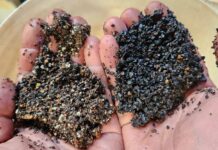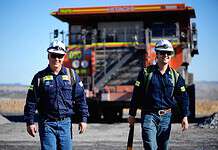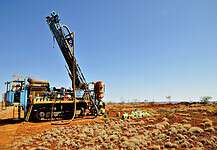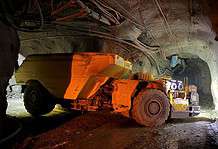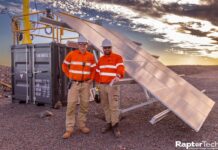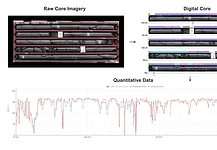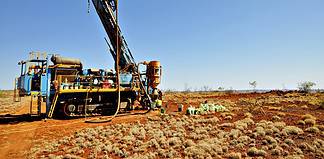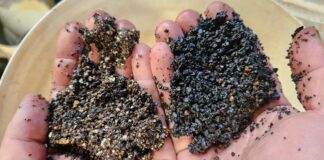All images: Gascoyne Resources.
BY ELIZABETH FABRI
THE lights turned on at Gascoyne Resources’ Dalgaranga project earlier this year; now, the miner’s focus is on achieving commercial production and continued exploration to extend mine life.
It’s been two months since first gold was poured at Gascoyne Resources’ $100 million Dalgaranga project in the Murchinson region, WA.
Bringing any new project into production is a milestone, but for Gascoyne Resources, this represented something bigger.
First gold marked the beginning of the company’s transition from explorer to a producer among the ranks of ASX-listed gold miners.
Gascoyne Resources managing director Mike Dunbar said to say that he was pleased “would be a massive understatement”.
“The company has managed to put together a fantastic team which has grown the global resource base from under 200,000oz on listing, to now having two gold projects [Dalgaranga and Glenburgh] which each contain more than 1 million ounces,” Mr Dunbar said.
“We have built a 100 per cent owned new gold processing facility and associated infrastructure under budget and ahead of schedule.”
With Dalgaranga production in full swing, the miner’s next goal was to ramp up performance at the processing plant.
Operational Update
On 25 July, Gascoyne announced Dalgaranga’s process plant performance test had been completed, and a design mill throughput rate of 2.5 million tonnes per annum (mtpa) had been consistently achieved.
“The test confirmed that all aspects of the processing plant are running at least at nameplate capacity and in many cases better than expected,” Mr Dunbar said.
Results from the performance test included crusher throughputs up to 450 tonnes per hour (t/hr); milling rates of up to 365t/hr; gold recovery of 94 per cent; and plant availability of 99 per cent during the test.
Mr Dunbar said to date more than 7400 ounces of gold had been recovered from the plant.
“The mining ramp up is continuing, with total monthly movement rates for June of around 1.4 million BCM achieved, with the rates expected to increase to around 1.9 million BCM per month from late in the current quarter,” he said.
“The mining rates have been lower than projected to date, largely due to site establishment taking longer than expected and lower than planned machine availability in the early stages of mining, along with delays due to rain in June and some unplanned additional blasting required for near surface hardpan material.”
Mr Dunbar said once the mining rate had increased, commercial production would then be declared.
“This is likely to be either late in the current quarter or early next quarter,” he said.
Gascoyne Resources had also begun selling gold into its existing hedge program (176,000oz at an average forward price of $1716/oz).
Increasing Mine Life
In addition to ramp up activities, the Gascoyne Resources team were continuing exploration at the project.
The 1.3 million ounce (and growing) resource will currently produce 100,000 ounces of gold per annum for an initial six years.
Mr Dunbar said Gascoyne remained focused on its aggressive exploration effort to increase the mine life to between eight and 10 years across its Sly Fox, Gilbeys, and Golden Wings deposits.
Newly discovered Plymouth was also marked as a significant prospect at Dalgaranga.
In June the company said it had encountered 6.2 grams per tonne at Plymouth, which was conveniently 150m north-west of the current Sly Fox open pit.
Results from a further 40 RC drill holes were still to be announced.
Gascoyne’s newly acquired Greencock tenements – 7.5km from the Dalgaranga processing plant— also looked promising.
Greencock, purchased from a private prospector in December, is considered to be highly prospective for gold and base metal mineralisation, with strong synergies with the existing Dalgaranga tenements.
Earlier this year, Gascoyne said Greencock contained historic prospects that had not been drilled in more than 17 years.
“The prospect remains open at depth and along strike, some of the better intersections from historical drilling at the prospect include; 15m at 1.5g/t gold, 19m at 1.6g/t gold, 15m at 1.1g/t gold and 10m at 1.1g/t gold,” the company stated.
Developing Glenburgh
Beyond Dalgaranga, Gascoyne would continue to advance its other 1 million ounce gold project, Glenburgh.
The 100,000ozpa project, within the company’s namesake Gascoyne region, was actually its initial first choice to bring into production before Dalgaranga was acquired.
A preliminary feasibility study was completed back in 2013, and a granted mining lease with native title agreement was in place, with no environmental issues identified.
Now with Dalgaranga up and running, the company was free to pour capital into this second production stream.
A 30,000 metre drilling program will be undertaken this year to confirm and extend the known resources, and test regional targets, which will be incorporated into an updated preliminary feasibility study.
All going well, Gascoyne said it hoped to begin production in late 2020, which would enable it to double annual production to 200,000ozpa.



